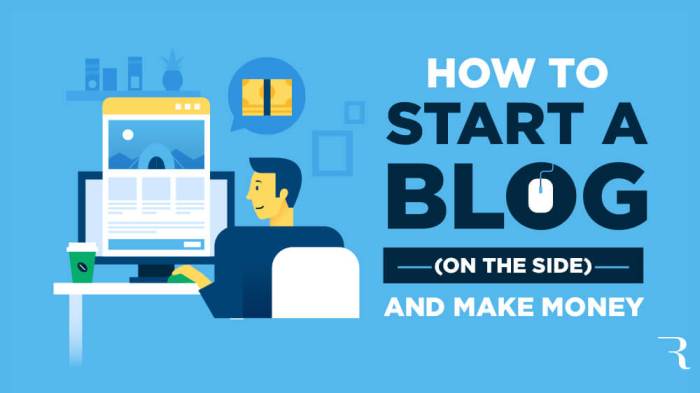How to Start a Blog sets the stage for your digital journey into the world of blogging. Get ready to dive into the essentials of creating a successful blog that stands out in the online crowd.
From choosing the right platform to crafting engaging content, this guide will equip you with the tools and knowledge needed to kickstart your blogging adventure.
Introduction to Blogging
A blog is a type of website where an individual or a group of people regularly post written content, images, videos, or other media on a specific topic or topics. Blogs can serve as online journals, informational resources, creative outlets, or platforms for sharing opinions and experiences.
Starting a blog can have numerous benefits, such as:
Increased Visibility and Influence
- By consistently creating valuable content, you can attract a larger audience and establish yourself as an authority in your niche.
- Increased visibility can lead to opportunities for collaborations, sponsorships, and partnerships with brands and other bloggers.
Personal and Professional Growth
- Writing regularly can help you improve your communication skills, creativity, and critical thinking abilities.
- Blogging can also be a platform to showcase your expertise, skills, and passions, which can open up new career opportunities.
Community Building
- Blogs can create a sense of community among like-minded individuals who share common interests, values, or goals.
- Interacting with readers through comments and social media can help build relationships and a loyal following.
According to recent statistics, blogging continues to grow in popularity:
“Over 60% of businesses have a blog or plan to start one in the near future.”
“There are over 600 million blogs worldwide, with more being created every day.”
Choosing a Blogging Platform
When it comes to starting a blog, one of the most crucial decisions you’ll make is choosing the right platform to host your content. There are several popular options out there, each with its own set of features and benefits. Let’s take a look at some of the most common platforms – WordPress, Blogger, and Wix – to help you make an informed decision.
WordPress
WordPress is one of the most widely used blogging platforms, known for its flexibility and customization options. Here are some factors to consider when choosing WordPress:
- Pros:
- Extensive theme and plugin options for customization
- Great for optimization
- Large community support and resources
- Cons:
- Requires some technical knowledge to set up and manage
- Can be overwhelming for beginners
Blogger
Blogger is a user-friendly platform owned by Google, making it easy to integrate with other Google services. Here are some things to consider with Blogger:
- Pros:
- Simple and easy to use interface
- Integrated with Google AdSense for monetization
- Reliable and secure hosting by Google
- Cons:
- Limited design and customization options
- Not as feature-rich as other platforms
Wix
Wix is a drag-and-drop website builder that also offers blogging capabilities. Here are some considerations for choosing Wix as your platform:
- Pros:
- Easy to use drag-and-drop interface
- Wide range of design templates
- Integrated e-commerce options
- Cons:
- Limited capabilities
- Can be expensive for advanced features
Setting Up Your Blog
When it comes to setting up your blog, there are a few key steps you need to take to get started. This includes registering a domain name, choosing a hosting service, and installing your chosen blogging platform.
Registering a Domain Name
To register a domain name for your blog, follow these steps:
- Brainstorm and choose a unique domain name that represents your blog.
- Check the availability of your chosen domain name on domain registration websites.
- Select a domain registrar and purchase your desired domain name.
- Provide accurate contact information during the registration process.
- Renew your domain name registration annually to maintain ownership.
Choosing a Hosting Service
Selecting a reliable hosting service is crucial for your blog’s performance and security. Here’s how to choose a hosting service:
- Research and compare hosting providers based on your budget and needs.
- Consider factors like server uptime, customer support, and scalability options.
- Choose a hosting plan that aligns with your blog’s traffic and storage requirements.
- Sign up for a hosting plan and complete the registration process.
- Set up your domain name to point to the hosting provider’s servers.
Installing Your Blogging Platform
After registering your domain and choosing a hosting service, it’s time to install your preferred blogging platform. Here’s how to do it:
- Access your hosting account’s control panel (cPanel) or use a one-click installer.
- Choose your blogging platform (such as WordPress, Blogger, or Drupal) from the available options.
- Follow the installation instructions provided by the platform or hosting provider.
- Create an admin account and customize your blog’s settings and design.
- Start creating and publishing content to engage your audience.
Designing Your Blog
When it comes to designing your blog, the visual appeal and user-friendly layout are crucial factors to consider. Customizing the design elements will help make your blog stand out and attract more readers.
Selecting a Visually Appealing Theme, How to Start a Blog
- Choose a theme that reflects your style and niche.
- Opt for a clean and simple design to enhance readability.
- Consider responsive themes that look good on all devices.
- Look for themes with customizable color schemes to match your branding.
Creating a User-Friendly Layout
- Organize your content in a logical way for easy navigation.
- Include a search bar and clear menu options for quick access to different sections.
- Avoid cluttered layouts and use white space effectively to improve readability.
- Ensure that your blog is mobile-friendly for users on the go.
Customizing Design Elements
- Personalize your header, logo, and background to make your blog unique.
- Add custom widgets and plugins to enhance functionality.
- Experiment with different fonts and typography to find the best fit for your content.
- Regularly update and refresh your design to keep your blog looking fresh and engaging.
Creating Quality Content

Creating quality content is essential for the success of your blog. It not only helps you attract more readers but also keeps them engaged and coming back for more. Here are some tips to help you create valuable and engaging content:
Brainstorming and Generating Blog Post Ideas
When it comes to brainstorming and generating blog post ideas, it’s important to consider your target audience and what they would find interesting or helpful. Here are some tips to help you come up with great ideas:
- Consider your own experiences and expertise
- Look at what other successful bloggers in your niche are writing about
- Ask your readers for feedback or suggestions
- Use tools like Google Trends or BuzzSumo to see what topics are trending
Different Content Formats
There are various content formats you can use to keep your blog interesting and engaging. Some popular formats include:
- Articles: Well-written and informative articles are a staple for any blog.
- Videos: Creating videos can help you connect with your audience on a more personal level.
- Infographics: Visual content like infographics can help break down complex information in a more digestible way.
Promoting Your Blog
To ensure the success of your blog, it’s crucial to promote it effectively. This involves driving traffic to your site, utilizing social media platforms, and optimizing for search engines to increase visibility and reach.
Driving Traffic to Your Blog
- Engage with your audience through comments and feedback to build relationships and encourage repeat visits.
- Collaborate with other bloggers or influencers in your niche to reach a wider audience and gain credibility.
- Guest post on reputable websites to establish authority in your field and attract new readers to your blog.
- Utilize email marketing campaigns to keep your audience informed about new content and drive traffic back to your blog.
- Participate in online forums and communities related to your blog’s topic to share your expertise and attract interested readers.
Role of Social Media in Promoting Your Blog
- Share your blog posts on popular social media platforms like Facebook, Twitter, Instagram, and Pinterest to reach a larger audience and drive traffic to your site.
- Engage with your followers by responding to comments, asking questions, and sharing relevant content to build a loyal community around your blog.
- Utilize social media advertising to target specific demographics and increase visibility for your blog among potential readers.
- Collaborate with social media influencers to promote your blog and reach a wider audience in your niche.
Leveraging for Increased Visibility
- Research relevant s for your blog posts and optimize your content to rank higher in search engine results pages (SERPs).
- Optimize your blog’s meta tags, headings, and images with relevant s to improve search engine visibility and attract organic traffic.
- Create high-quality, engaging content that provides value to your readers and encourages them to share and link to your blog.
- Regularly update your blog with fresh content to signal to search engines that your site is active and relevant to your target audience.
Engaging with Your Audience: How To Start A Blog

Building a community around your blog is crucial for long-term success. It helps create a loyal following, increases reader engagement, and can even lead to collaborations or partnerships. Here are some tips on how to effectively engage with your audience:
Responding to Comments
Responding to comments on your blog shows your readers that you value their input and care about their opinions. Make sure to reply to comments promptly and thoughtfully. Acknowledge their feedback, answer any questions they may have, and encourage further discussion.
Creating Interactive Content
Interactive content is a great way to keep your audience engaged and coming back for more. Consider incorporating polls, quizzes, surveys, or interactive infographics into your blog posts. This not only makes your content more engaging but also encourages reader participation.
